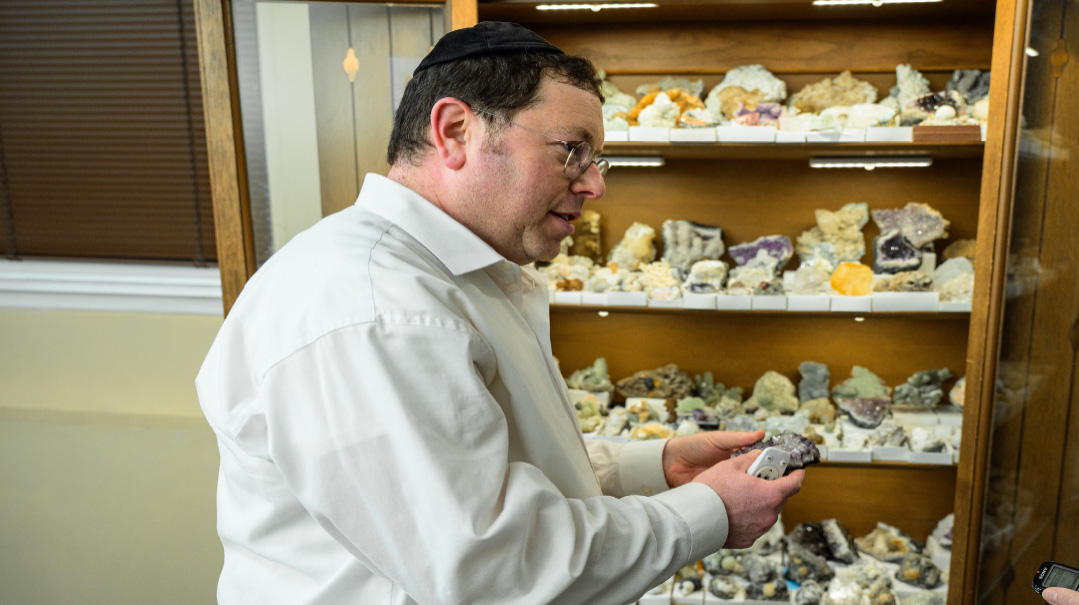Lookout for Peace
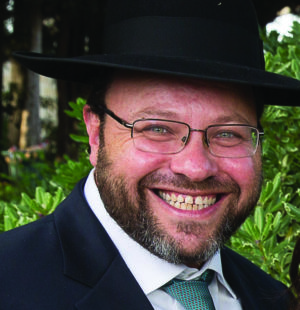
The Golan was Moshe Rabbeinu's conquest and our eternal inheritance
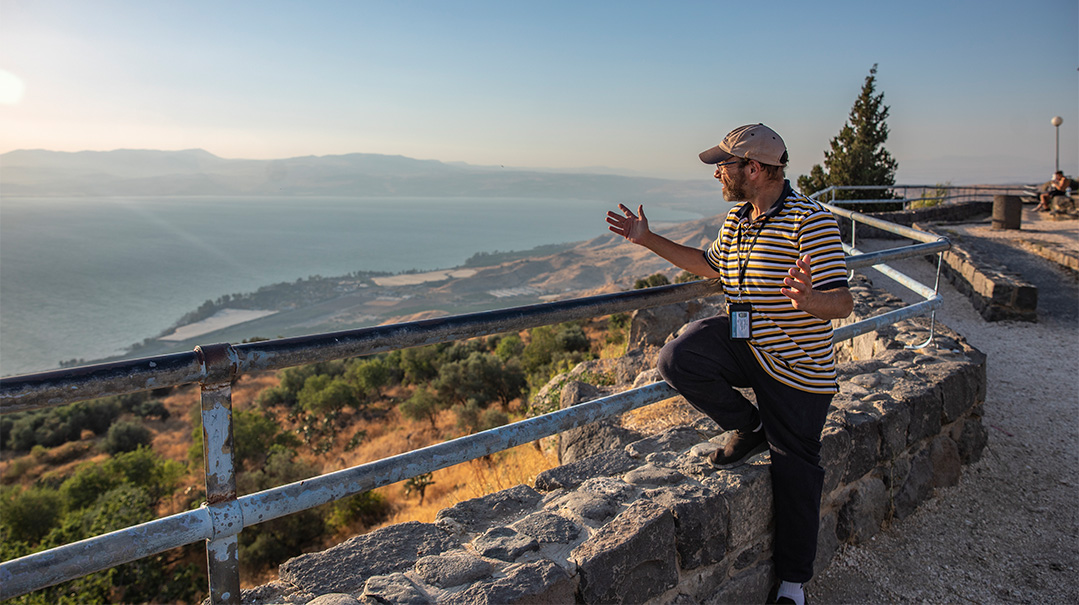
Photos: Menachem Kalish
One of the most inspiring aspects of any tour in Eretz Yisrael is the experience of treading on the same ground where our ancestors whose stories we study about took place. We can trace the path of Avraham Avinu, stand in the places where all the battles in Sefer Shoftim occurred, visit the spot where Dovid slayed Goliyas.
Yet there is one figure people don’t think about when touring Eretz Yisrael, because he never came into the Land of Israel. That person is Moshe Rabbeinu. Yet the fact that Moshe never entered the Land isn’t entirely accurate. The tribes of Reuven, Gad, and half of the tribe of Menashe, almost 20 percent of Klal Yisrael, would have been quite insulted had you insinuated that they weren’t living in Eretz Yisrael. In fact, this area on the eastern side of the Jordan River where the lands of Sichon and Og, conquered by Moshe Rabbeinu and — as we read in parshas Mattos — given to these tribes (and according to several commentaries, including Rashi on the brachah given to Gad, they wanted these lands in order to dwell in proximity to Moshe Rabbeinu’s hidden place of burial).
Although this area has a different level of sanctity than the land to the west (between the Jordan River and the Mediterranean Sea, the land referred to as “flowing with milk and honey"), according to most authorities, it too is obligated in laws of shemittah, terumos, and maasros.
So let’s follow in Moshe Rabbeinu’s footsteps and explore the area east of the Jordan River that he indeed conquered — known in modern times as the Golan Heights. (Even the US finally agreed that it’s part of Israel, so how can we not?)
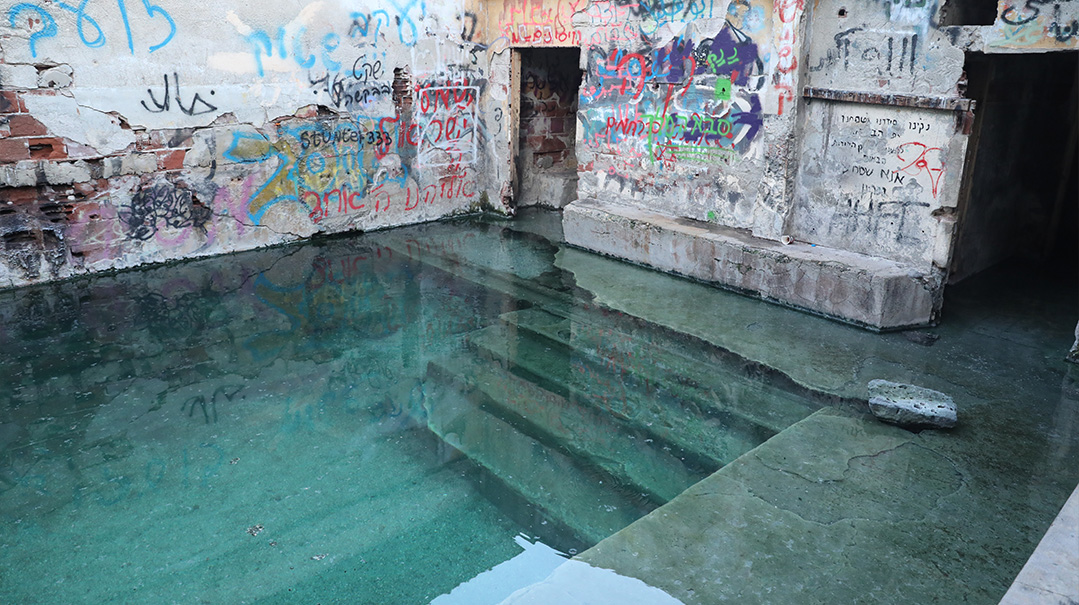
Who needs a fancy spa when you can enjoy an ancient Roman bath with hot springs from the time of the Mishnah, hidden in the brush?
In Hot Water
We start our tour looking out at modern Israel’s eastern border with Syria and Jordan, near the famous ancient hot springs of Hammat Gader. There are big yellow signs warning that this is a military area and that “Anyone who passes is putting himself in mortal danger.” Israelis like to be dramatic to get its citizens to pay attention. And for good reason: All along this border there’s an electric fence and barbed wire, mostly as a precaution against the still-active minefields that were placed here by enemy countries.
Today Chamat Gader contains a popular spa built on its historic hot springs and baths. Other attractions include the largest crocodile farm in the Middle East, with over 200 species of crocodiles, some which under good conditions can live for over a century. There is also a petting zoo and parrot farm. And although the spa and pools are generally mixed, on many Thursday nights they have separate men-only swim nights until the early morning hours, complete with someone who sells cholent. Is there a Leil Shishi better than that?
Actually, the ancient Roman hot springs and baths are not in the spa at all, but on the hidden road past those foreboding military signs near the Ein Jonis springs. That’s where the Israeli bathers “in the know” go — preferring to bathe in the abandoned former Syrian army bases than pay the entrance fee to Chamat Gader. The graffiti all over the wall tells us that many Na Nach Breslovers like this place, and that the Golan should always remain in our hands.
A few minutes’ walk from those pools, hidden in the brush, we come upon several huge ornate Roman pools and fountains. According to testimonies from the Roman period, there were seven bathhouses with separate rooms for different ailments that would be healed by these medicinal waters. There were lodgings, and even an ancient synagogue from the period of the Mishnah, whose mosaic today adorns the entrance to the Supreme Court in Jerusalem. (Does that mean that when they enter the court they’re getting into “hot water”?)
According to Rabi Yochanan, these hot springs remain from when Hashem opened the depths of the earth in the time of the Mabul. The Gemara discusses bathing in these waters on Shabbos, tells us of how Rabi Yehudah HaNasi would regularly come here with his students, and how the Amora Rabi Shmuel ben Nasan had some delicious eggs that were cooked here. There are not too many bathhouses still standing that are 2,000 years old, and the Antiquities Authority is busy making them usable once again for the masses.
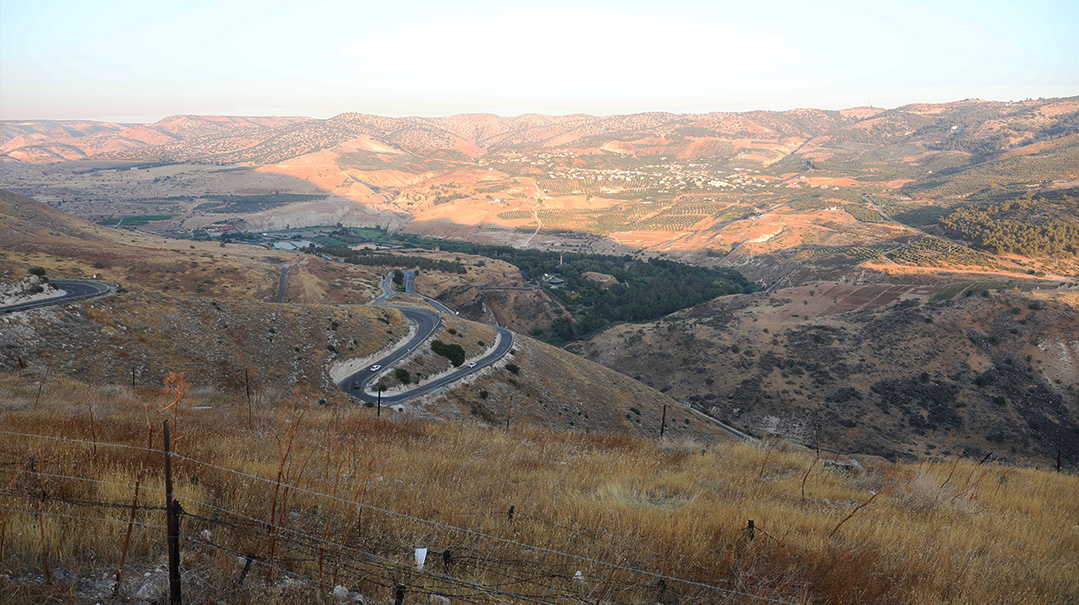
In Six Days
Leaving the baths, we begin the long windy road up to the Golan Heights. To our right is Jordan, but perhaps it too should be called “occupied territory,” as it’s sitting on the ancestral home of the tribes of Reuven and Gad. The northern part of this “occupied territory” is the area called the Gilad. It’s where the shofet Yiftach was from, and probably where Eliyahu Hanavi (“HaGiladi”) lived. Yet the name of this region originally comes from the pile of stones, or the “Gal Eid” monument that would be the testimony and peace treaty that Yaakov made with his father-in-law, Lavan, who caught up with him by the Yarmouk River that flows in the gorge below.
Looking down from the former Syrian army base, we can see the three countries — Syria, Jordan, and Israel — that share this river: To the north is Syria, from whom Israel captured this area on the last day of the 1967 Six Day War. Today it’s part of the demilitarized zone established in the ceasefire agreement after the Yom Kippur War with Syria. The river gorge below us was the site of a battle as well — perhaps one of the most important battles in the history of the world. It is here that the Muslims in the year 636 threw the Byzantines out of Israel and established the first Muslim Empire — and they also did it in a six-day war.
We see the old Ottoman-era bridge down below, part of the Hejazi railroad that went from the Mediterranean across Israel to Damascus. It was the longest bridge in Eretz Yisrael at that time. In June of 1946 the bridge was destroyed in the famous “Night of the Bridges,” when the Palmach blew up 11 bridges all around the country in defiance of the British White Paper. “If we can’t come in, then we’re not letting you in either,” was the message that night.

View of Peace
We continue up what I believe is the windiest road in Israel, to the plateau of the Golan Heights. This is no easy climb — we’re heading up from about 600 feet below sea level to about 3,000 feet above, nearly a mile straight up. Once on the top, we stop at Mitzpeh Hashalom, a lookout over the entire Kinneret and Galil. The name “Peace Lookout” was given once the land was returned to Israel’s hands in 1967, following 19 years of Syrian bombardment of the kibbutzim and fields down below. Almost one-third of Eretz Yisrael can be viewed from this point, and I can’t help thinking of Moshe Rabbeinu, who was perhaps standing right here as well, looking out longingly into the part of the Land he would never be able to enter.
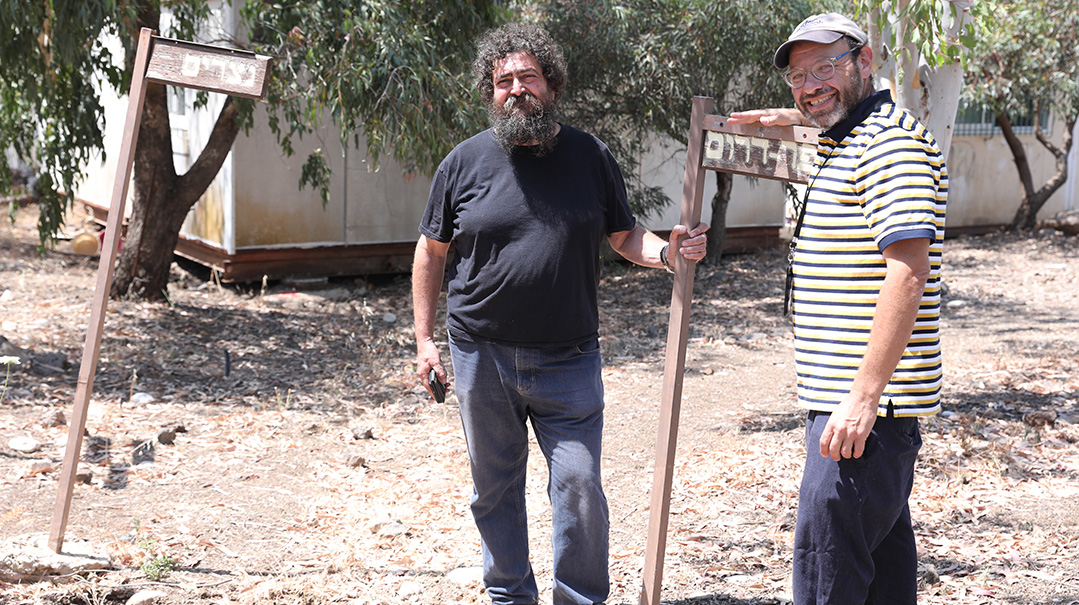
Yossi knew his family would be traumatized on the worst day of their lives
Rebuilt Dreams
Our next stop is to the small religious yishuv of Avnei Eitan, founded in 1978. In 2006, the village took in 16 families from Gush Katif who were thrown out of their homes the summer before. Those brave, traumatized families who had spent decades building their homes and business empires of bug-free agriculture had been promised the world when they were forcibly evicted, yet were afterwards abandoned and forgotten by the government. They lived in temporary homes, out of suitcases, while all their belongings were kept in containers — some of them for years. Yet for many, the settler in them could not be quelled, and some of those families resettled in the Golan to rebuild their dreams.
These families created a very special museum that’s worth a visit. Yossi, who moved here after his family was expelled from Kfar Darom, points out a large mosaic at the entrance to the visitors’ hall, a collaborative therapeutic project made by the families and their children in commemoration of the area they spent years bringing to life before it was snatched from them. Inside the hall we watch films of the history of Jewish life in Gaza — from the times of the Avos, the period of the Geonim, and early Acharonim — and the modern-day “paradise” life these idealists rebuilt on the desolate sand dunes the local Arabs maintained was cursed land.
Yossi, who moved here after being expelled from Kfar Darom, describes how his nine-year-old daughter Chelly’s school bus was targeted by terrorists and how he had almost thought that he lost her, as the Kassam missile killed the two teachers in front of her seat. Chelly’s face was covered with blood, but that was only because the missile scratched her head as it passed over her. A millimeter lower and it would’ve been a different story. After several more years under straining and difficult conditions (his family, and especially his children, insisted on staying put), the army finally came to take them away. On the day of their expulsion, when dozens of soldiers dressed in foreboding black stood in their yard, Yossi asked them to please let them leave without any army surrounding them.
He explained that he knew his children would suffer tremendous trauma on this worst day of their lives. Yet, he wanted his family to understand that this was a gezeirah from Hashem. This wasn’t the army. This wasn’t Ariel Sharon or the Left. He wanted his children to remain patriotic and to love and serve their country with the same dedication he had for so many years. He didn’t want them to hold it against the soldiers who were merely emissaries of HaKadosh Baruch Hu and His plan.
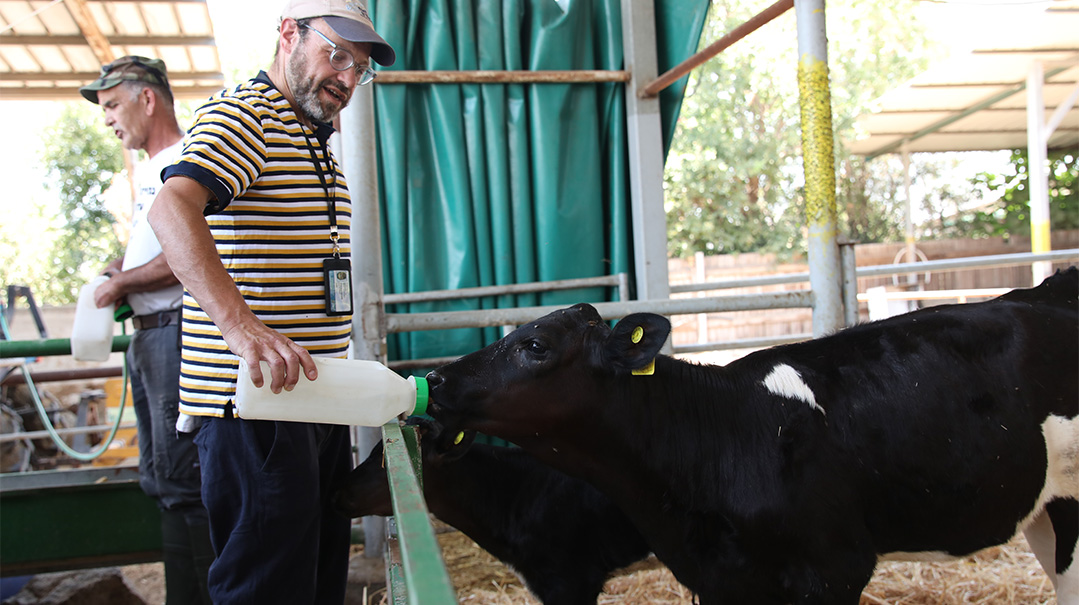
Seven Years of Miracles
We head out to the fields that surround the yishuv and meet Eyal Hadad, one of the many “gibborei koach” shemittah observers in the country. This is Eyal’s third shemittah. The hothouses that he rebuilt when he left Gush Katif stand proudly, and he claims that here in the Golan, a colder climate where fruit trees and grape vines grow, he’s seen miracles with his broccoli and cabbage harvests.
“They told me I was crazy,” he says. “They said, ‘This is not Gush Katif. The winters here are freezing. You won’t have anything.’” Today Eyal has the last laugh. He has over 25 dunams of bug-free crops with sales of over a million NIS per year. This year though, as in past shemittahs, he’s on vacation and back in kollel. He says it’s like Shabbos for him all year, and keeps him focused on the miracles of his business. One insect can destroy his entire crop. One snowstorm, of which he’s weathered quite a few, could have destroyed his hothouses. Yet, he feels how HaKadosh Baruch Hu has blessed him and watches over him. He points to the hothouse roof that traveled with him across the country from the warm Mediterranean Southern Gaza Strip all the way to the cold northern Golan and shows us how it doesn’t have even one rip, one repair or patch. “It’s Hashem’s field all seven years,” he says. “This year I just remember it more.”
The Torah tells us that the tribes of Gad and Reuven wanted to stay on this side of the Yarden because they had a lot of cattle and saw that this was good grazing land. Fast forward a few thousand years and today the Golan Heights remains the “Texas” of Eretz Yisrael. It’s where the cowboys live and the cattle graze. Here in Avney Eitan the Asis family has been running their cowshed for three generations. Saba Gad started in 1950 in the south of Israel with two cows that he purchased. His son Nechemia moved here in 1980, bringing the family business to the Golan.
What makes their cowshed unique is that the cows are milked by a robot. Whereas in the past Nechemia worked from morning to night hooking up the cows to milking machines, today the proud robot sits in the middle of their cowshed and the cows come to it when they wish to relieve themselves and empty their heavy udders, but not only — there’s also a little trough there that doles out some tasty nosh for them. Once they’re in, the robot zooms in on their four udders and automatically connects the milking machine to them one by one.
Each cow has a computerized necklace that registers as soon as they enter the robot. It knows how old they are, how much milk they should provide, how recent they were last in. Some come a few times a day, some less. And some try to sneak in just for the snack, but the robot identifies them and gives them 16 seconds to leave before it gives them a little electric zetz.
We learn a lot about cows here. Cheese, for example, can only naturally be made (without the addition of enzymes) from kosher animals. A cow is called parah because it is fruitful, as every part of the cow is used. Besides for the edible milk and meat, its skin is used for Torah, tefillin, and leather. The eyelashes are used for paintbrushes, many organs and the teeth are used for transplants, and even its manure is used to produce methane gas, which powers the country.
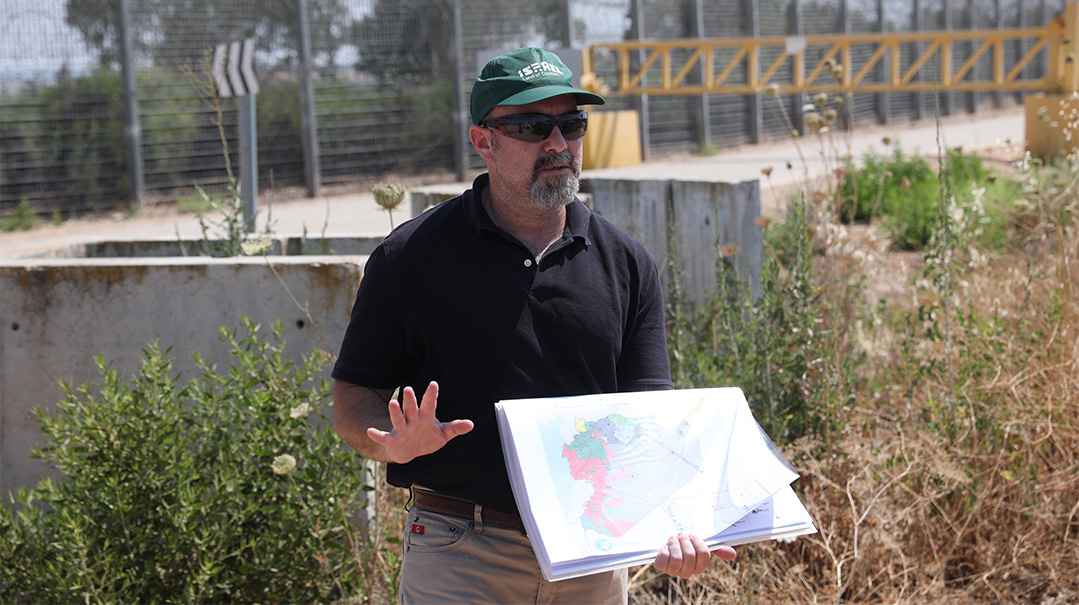
Avraham Levine shows us how close we really are to Iran
Prayer for Continued Quiet
When you think about it, it’s a little scary that the Golan settlements are practically a stone’s throw from the Syrian border. Brave as we are, we head out to the border, where we meet with Avraham Levine of the Alma Research and Education Center, dedicated to researching the security challenges on Israel’s northern borders. Avraham, a military intelligence officer originally from Nokdim in Gush Etzion, has been living in the Golan for many years.
As we stand on the imposing border fence a few kilometers from Syria, Avraham pulls out his maps and shows us the proximity to Iran, clearly Israel’s biggest threat. Our relatively quiet border with Syria, Iran’s proxy battleground, is really a border with Iran. For 40 years this border was the quietest in Israel. Yet with the Syrian civil war of the last decade, rebels came up through the demilitarized zone, while hundreds of thousands of refugees fled the country to Jordan and Turkey, hundreds of thousands more were killed, and many of those refugees got to the border with Israel and were treated in special wards in local hospitals.
Another major player in this area is Russia. Syria, with its borders on the Mediterranean and its proximity to Lebanon’s ports, has tremendous strategic importance to Putin. Before the war with Ukraine, Russia had over 10,000 troops in Syria. But now, many of those troops have been brought back to Russia and Iran’s power and influence is increasing. All you need to do is stand at the border fence to see how Israel is forced to walk the tightrope in its relations with Russia, who can either hold back Iran or challenge Israeli efforts to provide security in this area by arming Hezbollah and thwarting Israeli efforts to stymie Iran’s nuclear ambitions. Looking beyond the 24/7 surveilled electric fences, we hope and pray that the area continues to remain quiet for the long future as well.
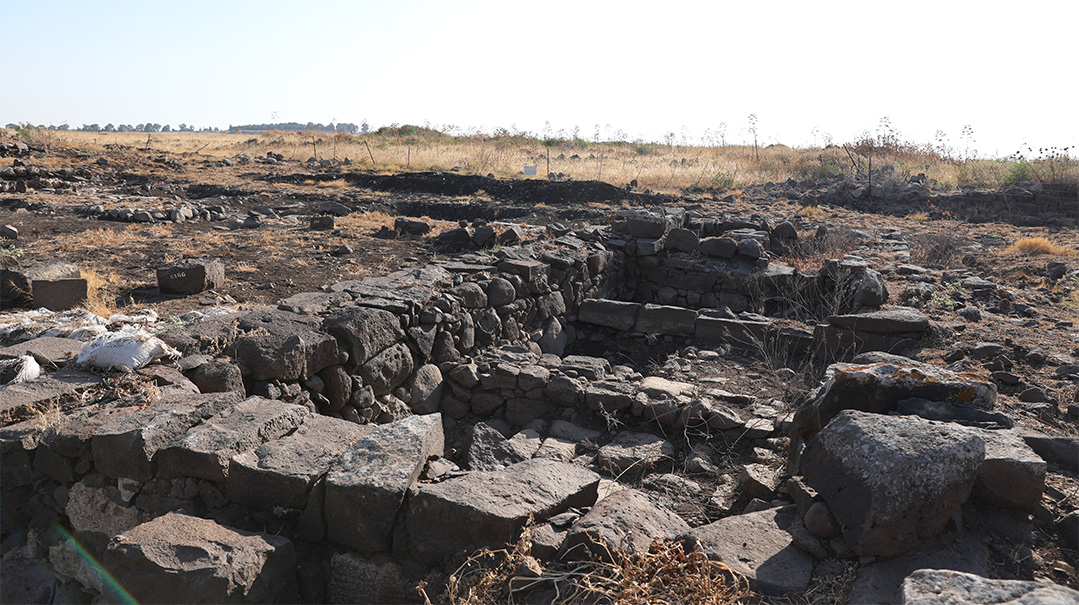
After the Churban, synagogues became central. Mickey Osband is helping to uncover what life was like for the Jews finding themselves around Roman pagans
No Mixing
From modern current events and foreboding borders, we head back in time to a peaceful and flourishing area: the archeological site of Natur. Lead archeologist Mickey Osband, who has been digging at this site for the past eight years under the auspices of the University of Haifa, found his passion in archeology as he uncovers sites from the times of the Mishnah that shed light on our ancestors’ lives in these parts.
With his tzitzis blowing in the wind, his rugged knapsack and tools on his back, Mickey, a native of Boston, has been helping to excavate and research a synagogue from the time of the Second Beis Hamikdash. Over 30 ancient shuls have been discovered in the Golan, most of which date to the periods of the Talmud between the fourth and seventh centuries, but only this one in Natur and one other date three centuries earlier — the second is the shul discovered in Gamla, which was the last stand of the Jews in the Great Revolt before Vespasian and his son Titus headed down to Yerushalayim.
Mickey says that this excavation has helped shed light on Jewish life during this early period after the Churban. Yerushalayim had been destroyed, and most of the population in these parts were Roman pagans. What was Jewish observance like, given their surroundings? How did they support themselves? What was their relationship with their Roman neighbors?
In this ancient shul, archaeologists uncovered benches that run all along and through the center of the shul. It also seems as if the entrance was expanded to meet the needs of a growing community. Shuls in this period were literally “batei knesset — houses of gathering.” In addition to the study of Torah and prayer, they would be places of community meetings and social gatherings. During the period of the Beis Hamikdash, Jewish life revolved around Yerushalayim where sacrifices would be brought, where the first fruits of this mostly agricultural country were offered, and where Jews would come at least three times a year with their families to be inspired. The order of tefillah and its canonization were established in place of the korbanos after this period when there was no longer the Beis Hamikdash and the center of Yiddishkeit. And so, it was in this period that shuls first began to evolve into the batei tefillah that we have today.
Other finds indicate that this was a community engaged with its neighbors, yet kept their own traditions. As opposed to the neighboring pagan cities where remains of non-kosher animals were found, none of that was found here; even the animal bones they found indicated that the animals were slaughtered through shechitah. Researchers uncovered an oven kiln, which would indicate that they made much of their own pottery rather than purchasing non-kosher ones from the gentiles, and they found many lanterns that seem to have been brought from Yerushalayim — which would indicate that the Jews traveled up here after being thrown out of their homes in the center.
We leave this ancient Jewish village, thinking about the families who lived here, forced to flee the destruction of their holy city. What did they endure? How did they persevere after seeing the Holy Temple in flames, reduced to soot and rubble? As we too are in this period of mourning the Beis Hamikdash, we can imagine their devastation on one hand, but at the same time hoping and looking to the future and to rebuilding. At least, they surely told themselves, they hadn’t been shipped off to Rome as slaves — they were still privileged to remain in Eretz Yisrael. They were still home.
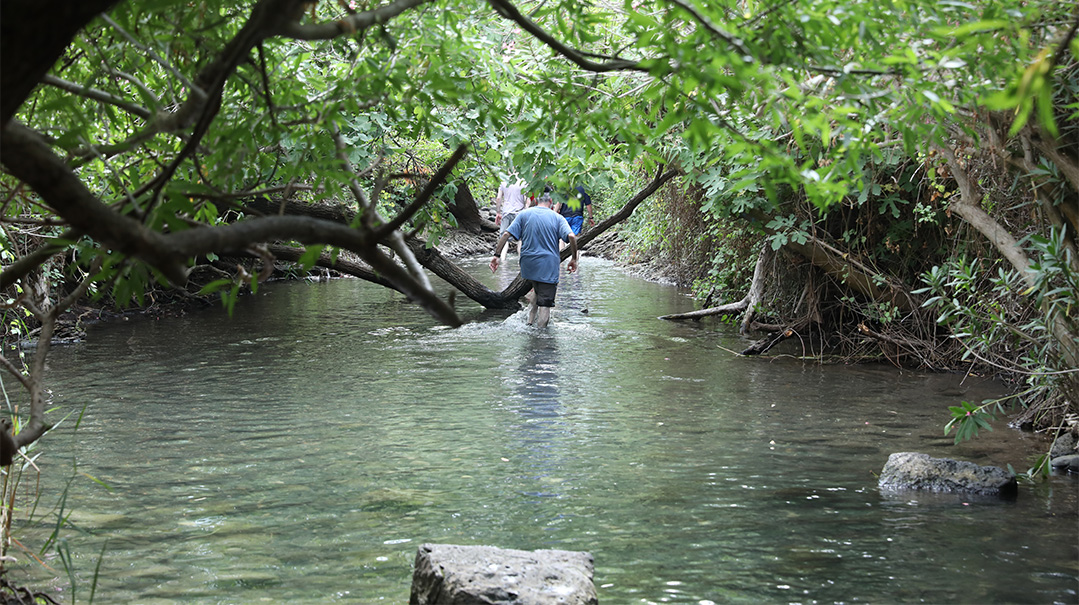
Still Waters
Our last stop after our long, hot day was to take a dip in the refreshingly cool waters of the Madrassa stream on the bottom of the Golan. The stream, located in the Beit Tzaida valley, is a delta where many of the streams of the Golan flow down to the Kinneret. The water flows there all year round and it feels a bit like we imagine Gan Eden, as we are surrounded by lush fig trees, eucalyptus and olive groves on all sides. At the end of the day, we’re quite happy to discover that we have the popular water trail pretty much to ourselves.
The Yerushalmi relates a story about a wagon of Rabi Yehudah Hanasi that was full of barrels of wine and went off the path here. The Jewish driver left the wagon with a non-Jew while he went for help, yet the Rabbis permitted the wine, even though it was left with a gentile guard. That was because here was a place of Jewish settlement, and the non-Jew would have been too nervous to touch the barrels.
As we float down the stream, we can’t help but think of all the generations before us who cooled off in these same waters. Perhaps they came down for a dip in the mikveh before davening in the shul above in Natur, or after working in their fields or grazing their cattle. The Golan, the area of Ever HaYarden, was the first part of Eretz Yisrael that was conquered and settled. May this month, this period of exile, turn into a period of redemption and rejoicing as the Shechinah, together with the Beis Hamikdash, return once again into our midst in Eretz Yisrael Hashleimah.
(Originally featured in Mishpacha, Issue 921)
Oops! We could not locate your form.



